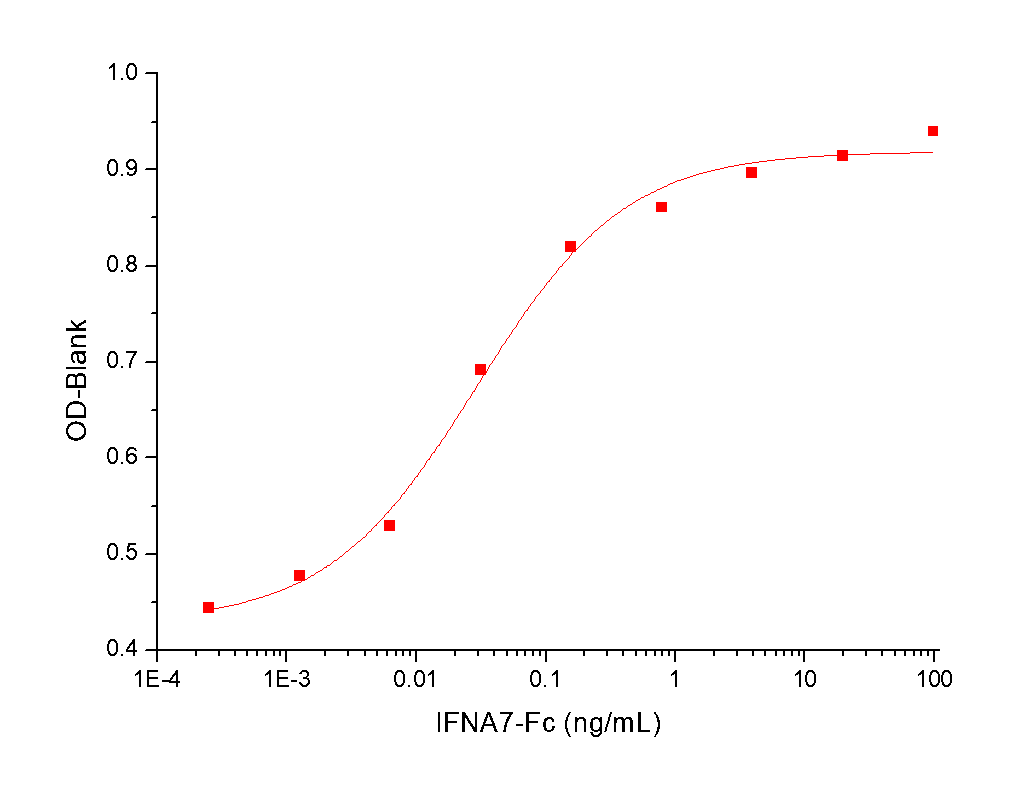Shopping Cart
- Remove All
 Your shopping cart is currently empty
Your shopping cart is currently empty

Interferon alpha 7/IFNA7 Protein, Human, Recombinant (hFc) is expressed in HEK293 mammalian cells with hFc tag. The predicted molecular weight is 48 kDa and the accession number is P01567.

| Pack Size | Price | Availability | Quantity |
|---|---|---|---|
| 100 μg | $177 | In Stock |
| Biological Activity | Measured in antiviral assays using WISH human amnion cells infected with vesicular stomatitisvirus (VSV). The ED50 for this effect is 0.1-1 ng/mL.  |
| Description | Interferon alpha 7/IFNA7 Protein, Human, Recombinant (hFc) is expressed in HEK293 mammalian cells with hFc tag. The predicted molecular weight is 48 kDa and the accession number is P01567. |
| Species | Human |
| Expression System | HEK293 Cells |
| Tag | N-hFc |
| Accession Number | P01567 |
| Synonyms | interferon, α7,interferon, alpha 7,IFN-αJ,IFN-alphaJ,IFNA-J |
| Construction | A DNA sequence encoding the human IFNA7 (P01567) (Cys 24-Asp 189) was fused with the Fc region of human IgG1 at the N-terminus. Predicted N terminal: Glu |
| Protein Purity | > 85 % as determined by SDS-PAGE  |
| Molecular Weight | 48 kDa (predicted); 50 kDa (reducing conditions) |
| Endotoxin | < 1.0 EU/μg of the protein as determined by the LAL method. |
| Formulation | Lyophilized from a solution filtered through a 0.22 μm filter, containing PBS, pH 7.4. Typically, a mixture containing 5% to 8% trehalose, mannitol, and 0.01% Tween 80 is incorporated as a protective agent before lyophilization. |
| Reconstitution | A Certificate of Analysis (CoA) containing reconstitution instructions is included with the products. Please refer to the CoA for detailed information. |
| Stability & Storage | It is recommended to store recombinant proteins at -20°C to -80°C for future use. Lyophilized powders can be stably stored for over 12 months, while liquid products can be stored for 6-12 months at -80°C. For reconstituted protein solutions, the solution can be stored at -20°C to -80°C for at least 3 months. Please avoid multiple freeze-thaw cycles and store products in aliquots. |
| Shipping | In general, Lyophilized powders are shipping with blue ice. |
| Research Background | Interferon alpha-7(IFNA7) is a member of the interferon family. Interferons belong to the group of the regulatory glycoproteins, of low molecular mass. They are the products of infected cell-genome, but not virus, as a consequence of the cause answer by different inductors. Interferon stimulates the production of two enzymes: a protein kinase and an oligoadenylate synthetase. They allow communication between cells to trigger the protective defenses of the immune system that eradicate pathogens or tumors. IFNs have other functions: they activate immune cells, such as natural killer cells and macrophages; they increase recognition of infection or tumor cells by up-regulating antigen presentation to T lymphocytes, and they increase the ability of uninfected host cells to resist new infection by the virus. Certain host symptoms, such as aching muscles and fever, are related to the production of IFNs during infection. Human IFN is divided on the sequence of amino-acids into three groups: Alpha, Beta, and Gamma interferons. |

Copyright © 2015-2025 TargetMol Chemicals Inc. All Rights Reserved.